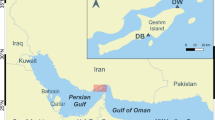Abstract
The feeding behavior of herring gulls (Larus argentatus), ringed-billed gulls (L. delawarensis) and great blackbacked gulls (L. marinus) on an intertidal mudflat in Maine, USA, was investigated. Remains of fish, mussels, crabs, insects, and the polychaeteNereis virens were recovered from gull feces. Forty-three percent of the fecal samples containedN. virens jaws, setae, or both. A comparison of jaws from fecal material and from worms collected from the natural community demonstrates that gulls preferentially preyed upon larger worms. Feeding was largely confined to 3 h around low tide, and birds fed mostly in the low intertidal and below mean low water where the largest worms were located. Individual birds remained on the flat for a mean of 28.0 min and consumed a mean of 19.2 worms per visit. It was calculated that gulls remove a mean of 808 largeN. virens from the flat per tide from June to October, representing an estimated 0.04% of the standing crop of largeN. virens.
Similar content being viewed by others
Literature cited
Ambrose, W. G., Jr.: Influences of predatory polychaetes and epibenthic predators on the structure of a soft-bottom community in a Maine estuary. J. exp. mar. Biol. Ecol.81, 115–145 (1984a)
Ambrose, W. G., Jr.: Influence of residents on the development of a marine soft-bottom community. J. mar. Res.42, 633–654 (1984b)
Ambrose, W. G., Jr.: Role of predatory infauna in structuring marine soft-bottom communities. Mar. Ecol. Prog. Ser.17, 109–115 (1984c)
Bergman, G.: Population dynamics, colony formation and competition inLarus argentatus, fucus andmarinus in the archipelago of Finland. Ann. Zool. Fennici19, 143–164 (1982)
Botton, M. L.: Effects of laughing gull and shore bird predation on the intertidal fauna at Cape May, New Jersey. Estuar. cstl. Shelf Sci.18, 209–220 (1984)
Commito, J. A.: Importance of predation by infaunal polychaetes in controlling the structure of a soft-bottom community in Maine, USA. Mar. Biol.68, 77–81 (1982)
Commito, J. A. and P. B. Shrader: Benthic community response to experimental additions of the polychaeteNereis virens. Mar. Biol.86, 101–107 (1985)
Commito, J. A. and W. G. Ambrose Jr.: Predatory infauna and trophic complexity in soft-bottom communities. Proc. Nineteenth Eur. mar. biol. Symp. Cambridge University Press. (In press)
Creaser, E. P.: Reproduction of the bloodworm (Glycera dibranchiata) in the Sheepscot estuary, Maine. J. Fish. Res. Bd Can.30, 161–166 (1973)
Creaser, E. P. and D. A. Clifford: Life history studies of the sandworm,Nereis virens Sars, in the Sheepscot Estuary, Maine. Fish. Bull. U.S.80, 735–743 (1982)
Evans, P. R.: Adaptations shown by foraging shorebirds to cyclic variations in the activity and availability of their intertidal invertebrate prey.In: Cyclic phenomena in marine plants and animals, pp 357–366. Ed. by E. Naylor and R. G. Hartnoll, Proc. Thirteenth Eur. mar. biol. Symp. Pergamon Press 1979
Evans, P. R., D. M. Herdson, P. J. Knights and M. W. Pienkowski: Short-term effects of reclamation of part of Seal Sands, Teesmouth, on wintering waders and Shelduck I. Shorebird diets, invertebrate densities, and the impact of predation on invertebrates. Oecologia41, 183–206 (1979)
Goss-Custard, J. D.: Ecology of the Wash III. Density-related behavior and the possible effects of a loss of feeding ground on wading birds (Charadrii). J. appl Ecol.14, 721–739 (1977)
Hancock, D. A. and A. E. Urquhart: The determination of natural mortality and its causes in an exploited population of cockles (Cardium edule L.). Fishery Invest. Lond. Ser. 2,24, 1–40 (1965)
Harris, M. P.: The food of someLarus gulls. Ibis107, 43–53 (1965)
Hunt, G. L. Jr.: Influence of food distribution and human disturbance on the reproductive success of herring gulls. Ecology53, 1051–1061 (1972)
Hunt, G. L., Jr. and M. W. Hunt: Habitat partitioning by foraging gulls in Maine and northwestern Europe. Auk90, 827–839 (1973)
Jackson, M. J. and R. James: The influence of bait digging on cockle,Cerastoderma edule, populations in North Norfolk. J. appl. Ecol.16, 671–679 (1979)
Kihlman, J. and J. L. Larsson: On the importance of refuse dumps as a food source for wintering herring gullsLarus argentatus Pont. Ornis Scand.5, 63–70 (1974)
Mudge, G. P. and P. N. Ferns: The feeding ecology of five species of gulls (Aves: Larini) in the inner Bristol Channel. J. Zool. Lond.197, 455–461 (1982)
O'Conner, R. J. and R. A. Brown: Prey depletion and foraging strategy in the oystercatcherHaematopus ostralegus. Oecologia27, 75–92 (1977)
Pettibone, M. H.: Marine polychaete worms of the New England region. I. Approditoidea through Trochaetidae. Bull. U.S. National Mus.227, 1–356 (1963)
Quammen, M.: Predation by shorebirds, fish, and crabs on invertebrates in intertidal mudflats: an experimental test. Ecology65, 529–537 (1984)
Schneider, D.: Equalization of prey numbers by migratory shorebirds. Nature, Lond.271, 353–354 (1978)
Schneider, D. C. and B. A. Harrington: Timing of shorebird migration in relation to prey depletion. Auk98, 801–811 (1981)
Sibly, R. M. and R. H. McCleery: The distribution between feeding sites of herring gulls breeding at Walney Island, U.K. J. Anim. Ecol.52, 51–68 (1983)
Sokal, R. R. and F. J. Rohlf: Biometry. W. H. Freeman and Company, San Francisco 1969
Spaans, A. L.: On the feeding ecology of the herring gullLarus argentatus Pont. in the northern part of the Netherlands. Ardea59, 73–188 (1971)
Verbeek, N. A. M.: Comparative feeding ecology of herring gullsLarus argentatus and lesser black-backed gullsLarus fuscus. Ardea65, 25–42 (1977)
Author information
Authors and Affiliations
Additional information
Communicated by T. Fenchel, Aarhus
Rights and permissions
About this article
Cite this article
Ambrose, W.G. Estimate of removal rate ofNereis virens (Polychaeta: Nereidae) from an intertidal mudflat by gulls (Larus spp.). Mar. Biol. 90, 243–247 (1986). https://doi.org/10.1007/BF00569134
Accepted:
Issue Date:
DOI: https://doi.org/10.1007/BF00569134




